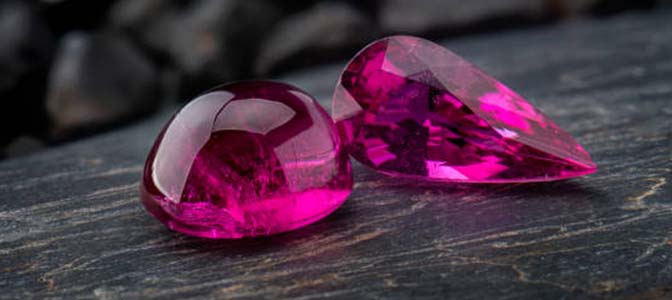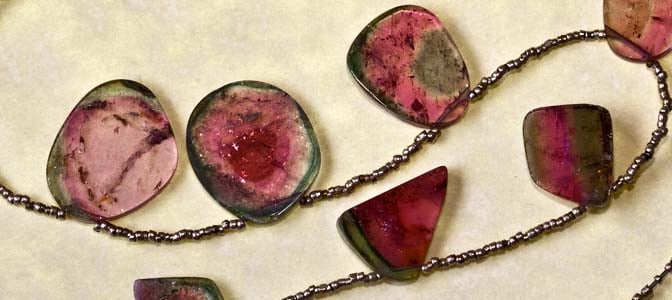No, it does not affect the crystalline surface of the gemstone.

Introduction
The word Tourmaline has originated from the word ‘turmali’ of the Sinhalese language meaning ‘mixed’. It truly defines what tourmaline is. The gemstone family displays a large spectrum of colours, imitating the appearance of the other gems that occur on earth. The vibrant gemstone family consists of a group of boron silicate minerals. Tourmaline varieties which are rich in iron and titanium attain green and blue hues.
The ones rich in manganese occur in red, pink, and yellow colours. Due to the vast number of colours in which it is available, every variety of the gemstone is assigned a different name. The pink and red tourmaline are addressed by ‘Rubellite’. The violet, blue and greenish-blue ones are called ‘Indicolite’, while the tourmalines rich in vanadium are called ‘Chrome’. The rarest of all, with the cuprous content, is called Paraiba, named after the city, where it was discovered first. The most fascinating amongst the gemstones is the watermelon tourmaline which has a pink centre juxtaposed with green on both sides and vice-a-versa.
Some combinations result in multi-coloured varieties of the gemstone. But bicolour and tricolour tourmalines are most common. The dark-hued tourmalines are heat-treated to lighten their hue, which gives them an appealing shade. The opaque brown and black tourmalines are generally not used in jewellery making. Some of the varieties display cat’s eye effect when cut in cabochons. The members of the family have a similar structure but different chemical and physical properties. Silicon, aluminium, and boron are present in all. It is the mixture of other elements (sodium, lithium, calcium, magnesium, manganese, iron, chromium, vanadium and fluorine more) that defines the properties of a particular tourmaline gem.
New Arrivals in Tourmaline

Origin & Supply
The journey of tourmaline as a gemstone started 500 years ago when a Spanish conquistador found a sparkling green crystal. He mistook it for emerald. For a long time, the mineral was seen as green and pink rubies, until science intervened. In 1892 George E. Kunz, a gemologist in California studied the green tourmalines found in Mount Mica Mine, Maine. He emphasized on the great quality of the gemstone in his findings. Soon, he went to Tiffany which primarily dealt in precious gemstone jewellery. He not only convinced Charles Tiffany to invest in the gemstone but also became the chief Gemologist for the luxury jewellery retailer for a lifetime initially, the gem was mined in the Minas Gerais state of Brazil. In the 1800s, it served as the largest source of tourmalines to the entire world.
Afterwards, in 1822 mines of tourmaline were discovered in the United States, at Maine. In the 1900s, several new mines were started in San Diego county of California. Soon, Americans became the largest producers of this gemstone, exporting large qualities of tourmaline to the neighbouring countries. The last empress of China, Dowager Tz'u Hsi was so fond of the pink tourmaline that she bought a copious amount of the gem from the US. Shortly after the Chinese government collapsed the US tourmaline trade also went down. However, that wasn’t the end of the beautiful gemstone’s story. In the 1950s, new reserves of the gem were found all around the world. Today Africa is one of the leading sources with Nigeria and Tanzania being the forerunners. The other countries which produce tourmaline gemstones are Afghanistan, Mozambique, Namibia, Pakistan, the United States, Madagascar, Russia, Burma (Myanmar) and Sri Lanka (Ceylon).
How is the Gemstone Mined?
The gemstone is hidden inside the pegmatite rocks. The miners have to dig deeper into the earth’s surface as low as 5 miles to reach the point where the gems are laid in the sediments of rocks. After the construction of tunnels, no specialized tools are used to extract the minerals from the pegmatite veins. Once the miners reach the gemstone pockets, they identify the crystal and pick it by hand. Only 5% of the total gemstone extracted are of the quality to be used in the jewellery making.

Facts About Tourmaline
- Tourmaline is the birthstone of October babies. It is also the gemstone for 8th anniversaries.
- The tourmaline gem acts like a magnet on heating. They attract lighter objects after being polarised by light. Due to this property, they were used for removing ashes from pipes in the Netherlands.
- In Brazil, tourmalines in almost every colour were dug in Minas Gerai mines. Initially, the green and pink tourmalines had all the hype. When the Paraiba tourmaline surfaced in 1989, the popularity of green and pink ones decreased. The new vivacious blue tourmalines were in high demand, sold at a cost of $10,000 and more per carat!
- Before tourmaline had not been identified, it was often confused with the other gemstones. The pink tourmalines studded on Russian crowns were thought to be rubies in the past. Some of the tourmaline encrusted on jewellery during the 1600s were thought to be zircons.
- During the 1600s, the East India Company bought huge qualities of Ceylonese tourmalines from Sri Lanka to Europe. They didn’t have the slightest idea it was tourmaline and mistaken it for zircons. Only after 1703, it was discovered the brown/black schorls were one of the varieties of the gemstone.
- It is also used as a healing crystal to balance the male-female energies, improve self-worth, reduce anxiety and fear, and to aid in having better communication with others. It also helps in keeping your mind more focussed.
- The Dravite specimens are named after the place where they were found, Drave district of Carinthia. Similarly, Elbaite tourmaline derives its name from the island of Elba in Italy, where they were first discovered.
- The Egyptians believed tourmaline gemstones formed when the rainbow thrust its way into the earth, which also attributed to the variety of the colours they occurred in.
- The last empress of Chi’ing Dynasty was such a huge fan of the gemstone that she breathed her last breath laying her head on a tourmaline pillow.
- The black species of the gemstone is said to infuse positivity in the wearer. It is believed to bring happiness and good luck. The Arabic goddess of faith and death, Manat is associated with the gemstone.

Features of Tourmaline
Cat’s Eye Effect Also called chatoyancy, the gemstone displays a slight cat’s eye effect. The most common examples are green, blue and pink tourmaline. However, the intensity of the cat’s eye is less in comparison to chrysoberyl. The cat’s eye effect is visible in the gemstone because of the sleek tube-like inclusions which arise during the formation. These fine inclusions are distributed in a wider area, so it isn’t intense. By choosing the right angle at the time of cutting and polishing, the cat’s eye effect can be given to tourmaline cabochons.
Hardness The gemstone has a hardness of between 7 to 7.5 Mohs. This makes it less prone to damages; thus, it is ideal for adorning jewellery.
Pleochroism The gem displays two or more colours depending on the angle of viewing. It appears dark down the C-axis and light-hued when held perpendicular to the long axis of the crystal. How vivid a gem will look depends largely on the cutter. If the gemstone is oriented right, the best face-up colour can be produced.
Colour Zoning Tourmaline is one of the few gemstones that displays a well-defined colour zoning. The atmospheric conditions result in the different hues within the same crystal. Generally, uniformity in hue is one of the primary factors to assess the quality of a gemstone but the zoned tourmalines have garnered appreciation worldwide becoming an exception. The bicolour gemstone variety is of great prominence amongst the specimen collections and designers. The vibrant zoned gems sometimes do not show the flawless clarity of the single hued tourmaline still they are priced for the unique combinations of colours.

What to remember When Buying Tourmaline?
Whenever you are buying tourmaline gemstone, the first and foremost factor to consider are the inclusions. Much like every gem, the Tourmalines can also have imperfections. They can be natural or caused by human errors such as cracks. The key is to know the type of inclusions which occur naturally in a gemstone. For an example - Rubellite always has visible eye inclusions as it is a Type 3 gemstone. So, if a seller claims a gemstone to be a rubellite with no inclusions, you are definitely looking at a fake stone.
In case of Tourmaline gem, the shape has nothing to do with the quality of the gemstone, it’s the cut that matters. A symmetrically cut gemstone offering maximum passage to light is the one you should look for.
Tourmalines are hardly found in larger sizes. The temperature and pressure on the crystal should constantly remain the same for it to form a bigger size. Rubellite and chrome tourmaline are rarely found in a size more than 5 carats and 2 carats respectively. Whereas Indicolite and Paraiba are hard to find in a weight above 2 carats. If you find a gemstone specimen larger than the conventional size, be sceptical.
FAQ's
Will Tourmaline get damaged by water?
Which hues should I prefer when buying a tourmaline?
The vivid blue, red and green colour tourmalines look spectacular. But if you can manage to purchase the electric green-to-blue ones you will definitely get a great resale price.
Is a watermelon tourmaline worth investing in?
A watermelon tourmaline which is 100% pure, i.e. not given any kind of treatments with no visible inclusions in a considerable size can fetch a good price. It all depends on the quality of the bicolour gemstone.
How can you tell the difference between a real and a fake tourmaline?
The gemstone displays pleochroism. To know whether the gemstone is a real tourmaline gem you can rotate it in various angles. If the colour is not changing, it is not a Tourmaline. There will be at least a slight variation in the hue even if it is a single hued gem. If you are buying a tourmaline for purposes other than decorating jewellery, strike it slightly with a steel blade. These blades have a hardness of 5.5 mohs, they can’t scratch tourmalines which have a hardness of 7 to 7.5 mohs.
Is tourmaline an expensive gemstone?
The price of the gemstone will generally depend on the size, colour and clarity. The most valued are the Paraibas which are sold at prices as high as $10,000 per carat. On the other hand, the yellow tourmalines are sold at a very cheap price at times.







































